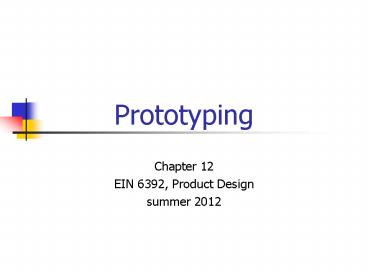Prototyping - PowerPoint PPT Presentation
Title:
Prototyping
Description:
Build parts in layers based on CAD model. SLA=Stereolithogrpahy Apparatus SLS=Selective Laser Sintering 3D Printing LOM=Laminated Object Manufacturing Others every ... – PowerPoint PPT presentation
Number of Views:89
Avg rating:3.0/5.0
Title: Prototyping
1
Prototyping
- Chapter 12
- EIN 6392, Product Design
- summer 2012
2
Product Design and DevelopmentKarl T. Ulrich and
Steven D. Eppinger
- Chapter Table of Contents
- 1. Introduction
- 2. Development Processes and Organizations
- 3. Product Planning
- 4. Identifying Customer Needs
- 5. Product Specifications
- 6. Concept Generation
- 7. Concept Selection
- 8. Concept Testing
- 9. Product Architecture
- 10. Industrial Design
- 11. Design for Manufacturing
- 12. Prototyping
- 13. Product Development Economics
- 14. Managing Projects
3
Concept Development Process
Mission Statement
Development Plan
Identify Customer Needs
Establish Target Specifications
Generate Product Concepts
Select Product Concept(s)
Set Final Specifications
Plan Downstream Development
Test Product Concept(s)
Perform Economic Analysis
Benchmark Competitive Products
Build and Test Models and Prototypes
4
Product Development Process
Concept Development
System-Level Design
Detail Design
Testing and Refinement
Production Ramp-Up
Planning
Prototyping is done throughout the development
process.
5
Outline
- Definition
- Steps in prototyping decisions
- Purposes of prototypes
- Principles for choosing a prototype type
6
Definition
- An approximation of the product along one or more
dimensions of interest. - Physical prototypes vs. analytical prototypes
- Comprehensive (with all the attributes of a
product) vs. focused
7
Purposes of prototypes
- Learning
- Learn whether it will work and how well it will
meet the customer needs - Communication
- Communicate with top management, vendors,
partners, extended team members, customers, and
sources of financing. - Integration
- Integrate into the product assembly to ensure
that components or subsystems fit well into the
product design. - Milestones
- Establish milestones for demonstrating that the
product has achieved a desired level of
functionality.
8
Types of Prototypes
Physical
beta prototype
alpha prototype
Physical models of components
final product
Components linked to other components or models
Comprehensive
Focused
Simulation models of product components
not generally feasible
equations modeling components
Analytical
9
Principles for choosing a prototype type
- Analytical prototypes are in general more
flexible than physical prototypes - Physical prototypes are required to detect
unanticipated phenomena - Prototypes may reduce the risk of costly
iterations - Prototypes may expedite other development steps
- Example add a prototyping step in the part
design-mold design-molding process
10
Purposes vs. prototype types
- Focused analytical
- Learning
- Focused physical
- Learning and communication
- Comprehensive physical
- Learning, communication, integration, and
milestones.
11
Technical risk vs. comprehensive prototype cost
- Low risk- low cost (e.g., printed matters)
- No need for comprehensive prototypes
- Low risk high cost (ships, buildings)
- Cant afford comprehensive prototype.
- High risk low cost (software)
- Many comprehensive prototypes
- High risk high cost (airplanes, satellites)
- Use analytical models extensively
- Carefully planned comprehensive prototypes
- Sell the first unit
12
Physical vs. Analytical Prototypes
- Analytical Prototypes
- Mathematical model of the product.
- Can only exhibit behavior arising from explicitly
modeled phenomena. (However, behavior is not
always anticipated. - Some behavior may be an artifact of the
analytical method. - Often allow more experimental freedom than
physical models.
- Physical Prototypes
- Tangible approximation of the product.
- May exhibit un-modeled behavior.
- Some behavior may be an artifact of the
approximation. - Often best for communication.
13
Focused vs. Comprehensive Prototypes
- Focused Prototypes
- Implement one or a few attributes of the product.
- Answer specific questions about the product
design. - Generally several are required.
- Comprehensive Prototypes
- Implement many or all attributes of the product.
- Offer opportunities for rigorous testing.
- Often best for milestones and integration.
14
Prototype technologies
- 3D computer modeling
- Free-form fabrication
- Stereolithography
- Using various materials including wax, resin,
paper, ceramics, and metals. - Lamination
- Using paper cut, lay by layer
- Rapid prototyping
- Laser curing (solidifying) soft materials such as
resin, layer by layer - 3D printing
15
Steps
- Define the purpose of the prototype
- Establish the level of approximation of the
prototype - Outline an experimental plan
- Create a schedule for procurement, construction,
and test - Plan milestones for prototypes (alpha, beta,
pre-production)
16
Prototyping ExampleApple PowerBook Duo Trackball
17
Boeing 777 Testing
- Brakes Test
- Minimum rotor thickness
- Maximum takeoff weight
- Maximum runway speed
- Will the brakes ignite?
- Wing Test
- Maximum loading
- When will it break?
- Where will it break?
18
Comprehensive Prototypes
Many comprehensive prototypes are built.
Some comprehensive prototypes build (and sold?).
High
Technical or Market Risk
One prototype may be used for verification.
Few or no comprehensive prototypes are built.
Low
High
Low
Cost of Comprehensive Prototype
19
Prototyping Strategy
- Use prototypes to reduce uncertainty.
- Make models with a defined purpose.
- Consider multiple forms of prototypes.
- Choose the timing of prototype cycles.
- Many early models are used to validate concepts.
- Relatively few comprehensive models are necessary
to test integration. - Plan sufficient time to learn from prototype
cycles. - Avoid the hardware swamp.
20
Rapid Prototyping Methods
- Most of these methods are additive, rather than
subtractive processes. - Build parts in layers based on CAD model.
- SLAStereolithogrpahy Apparatus
- SLSSelective Laser Sintering
- 3D Printing
- LOMLaminated Object Manufacturing
- Others every year...
21
Virtual Prototyping
- 3D CAD models enable many kinds of analysis
- Fit and assembly
- Manufacturability
- Form and style
- Kinematics
- Finite element analysis (stress, thermal)
- Crash testing
- more every year...
22
BMW Virtual Crash Test
From Scientific American, March 1999
23
Traditional Prototyping Methods
- CNC machining
- Rubber molding urethane casting
- Materials wood, foam, plastics, etc.
- Model making requires special skills.































